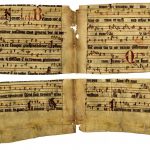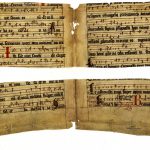For the description of the former host volume of the fragment see the online catalogue of the Library of HAS (ALEPH), in the Old Books – Rare Books (RBK):
The description of the fragment is available in the fragmentarium database:
https://fragmentarium.ms/overview/F-71k1
The fragment is an incomplete, in the middle cut bifolio of a 14th-century antiphonal, whose pieces almost precisely match. The first leaf of the bifolio fragmentarily preserved the first de apostolis office of the commune sanctorum, the second leaf, however begins with the last chant of the evangelists and continues with the chants of martyrs. This way, the original codex must have had at least one bifolium between the two leaves.
Both the musical notation and the liturgical-musical content confirms the monastic, Cistercian provenance of the original codex. Beside the coloured lines of the staves (red for F, yellow for C), the most telling features are the responsorium breve sang in the first vespers of the martyrs (with two different melodies for the martyrs and martyr bishops), the first four antiphons of the Matins’ first nocturne, and the unique canticle antiphon in the third nocturne of the Matins of apostles. The Regem sempiternum antiphon can also be counted as a Cistercian trait, which is documented only in a few French, German and Polish Cistercian sources by the Cantus database. The origins of the former codex can be placed in a German Cistercian monastery, taking in account the German elements of the notation (virga as a syllabic base symbol, the shapes of the clivis and cephalicus).
Zsuzsa Czagány



